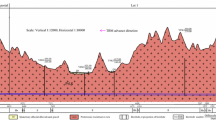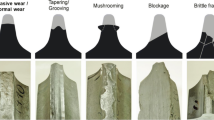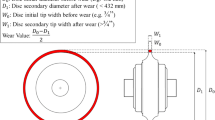Abstract
Replacing worn disc cutters in a tunnel boring machine (TBM) operation is a time-consuming and expensive process. This article presents the study of disc cutter wear rate during the excavation of 36 km Naqadeh water conveyance tunnel with a diameter of 6.325 m. The construction of this tunnel in northwest Iran has been recently completed. The geological setting of the tunnel consists of variable lithology, including limestone, shale, granite, and granodiorite units. Field data were collected and analyzed from TBM tunneling of 9.5 km of the tunnel. The analysis was performed by incorporating the types of wear and comparing the accuracy of traditional cutter wear prediction models. The new model was developed using statistical analysis of the observed cutter wear in this project. The validity of the proposed model was evaluated using the excavation data for the following 2 km of the tunnel. The model developed in this study allows estimating wear rate and cutter life using common rock characterization parameters such as the Cerchar abrasivity index (CAI) and the uniaxial compressive strength (UCS).



















Similar content being viewed by others
Abbreviations
- AVS:
-
Abrasion value
- B1, B2, B3:
-
Brittleness indices
- BTS:
-
Brazilian tensile strength
- CAI:
-
Cerchar abrasivity index
- CLI:
-
Cutter life index
- CSM:
-
Colorado school of mines
- DRI:
-
Drilling rate index
- dtbm :
-
TBM diameter
- Ef:
-
Average cutter life
- Es:
-
Specific energy of entire cutterhead
- F:
-
Test for the analysis of variance
- Hf :
-
Average cutter life (m3/cutter)
- Hh :
-
Average cutter life (h/cutter)
- Hm :
-
Average cutter life (m/cutter)
- Hn :
-
Number of replaced disc cutters
- TBM:
-
Tunnel boring machine
- Hri:
-
Relative cutter life
- Is50:
-
Point load index
- Ni:
-
Cutter position number
- NTBM :
-
Actual number of disc cutters
- R:
-
Coefficient of regression
- R2 :
-
Coefficient of determination
- rri:
-
Relative position of disc cutter
- S20:
-
Brittleness test
- SJ:
-
Sievers J-value test
- TBM:
-
Tunnel boring machine
- UCS:
-
Uniaxial compressive strength
- Vc:
-
Average cutter life (m3)
- OM:
-
Optical microscopy
- HRC:
-
Rockwell hardness c scale
- VHNR:
-
Vickers hardness number
References
Aghanabati A (2004) Geology of Iran. Geological Survey of Iran, Tehran (in Persian)
Altindag R (2002) The evaluation of rock brittleness concept on rotary blast hold drills. J South Afr Inst Min Metall 102:61–66
Barzegari G, Uromeihy A, Zhao J (2012) A newly developed soil abrasion testing method for tunneling using shield machines. Q J Eng Geol Hydrogeol 46:63–74. https://doi.org/10.1144/qjegh2012-039
Barzegari G, Uromeihy A, Zhao J (2014) EPB tunneling challenges in bouldery ground: a new experience on the Tabriz metro line 1, Iran. Bull Eng Geol Environ 73:429–440
Barzegari G, Uromeihy A, Zhao J (2015) Parametric study of soil abrasivity for predicting wear issue in TBM tunneling projects. Tunn Undergr Space Technol 48:43–57
Bieniawski Z, Celada B, Galera J, Tardáguila I (2009) Prediction of cutter wear using RME. Universidad Politecnica de Madrid, Spain
Bruland A (1998) Hard rock tunnel boring. Dissertation. Norwegian university of Science and Technology (NTNU)
Budinski KG (2007) Guide to friction, wear, and erosion testing. ASTM International, West Conshohocken, PA
Dahl F, Grøv E, Breivik T (2007) Development of a new direct test method for estimating cutter life based on the Sievers’ J miniature drill test. Tunn Undergr Space Technol 22:06–116
Deketh H, Grima MA, Hergarden I, Giezen M, Verhoef P (1998) Towards the prediction of rock excavation machine performance. Bull Eng Geol Environ 57:13–15
Ellecosta P, Kasling H, Thuro K (2018) Tool wear in TBM hard rock drilling backgrounds and special phenomena. Geomech Tunn 11(2):142–148. https://doi.org/10.1002/geot.201800006
Ewendt D (1992) Erfassung der Gesteinsabrasivität und Prognose des Werkzeugverschleißes beim maschinellen Tunnelvortrieb mit Diskenmeißeln. Kurzberichte Aus Der Bauforschung 33:9
Filbà M, Salvany JM, Jubany J, Carrasco L (2016) Tunnel boring machine collision with an ancient boulder beach during the excavation of the Barcelona city subway L10 line: a case of adverse geology and resulting engineering solutions. Eng Geol 200:31–46
Frenzel C (2011) Disc cutter wear phenomenology and their implications on disc cutter consumption for TBM, in: Proceedings 45th US Rock Mechanics/Geomechanics Symposium, San Francisco, California, June 2011. Paper Number: ARMA-11-211
Frough O, Torabi SR (2013) An application of rock engineering systems for estimating TBM downtimes. Eng Geol 157:112–123
Gehring K (1995) Prognosis of advance rates and wear for underground mechanised excavations. Felsbau 13:439–448
Hassanpour J (2018) Development of an empirical model to estimate disc cutter wear for sedimentary and low to medium grade metamorphic rocks. Tunn Undergr Space Technol 75:90–99
Hassanpour J, Rostami J, Azali ST, Zhao J (2014) Introduction of an empirical TBM cutter wear prediction model for pyroclastic and mafic igneous rocks; a case history of Karaj water conveyance tunnel, Iran. Tunn Undergr Space Technol 43:222–231
Hassanpour J, Rostami J, Zhao J, Azali ST (2015) TBM performance and disc cutter wear prediction based on ten years experience of TBM tunneling in Iran. Geomech Tunn 8:239–247
Hucka V, Das B (1974) Brittleness determination of rocks by different methods. Int J Rock Mech Mining Sci Geomech Abstr 11:389–392
Jakobsen PD, Lohne J (2013) Challenges of methods and approaches for estimating soil abrasivity in soft ground TBM tunneling. Wear 308:66–73
Karami M, Zare S, Rostami J (2020) Tracking of disc cutter wear in TBM tunneling: a case study of Kerman water conveyance tunnel. Bull Eng Geol Environ. https://doi.org/10.1007/s10064-020-01931-7
Kasling H, Thuro K (2010) Determining rock abrasivity in the laboratory, European Rock Mechanics Symposium EUROCK 2010, Lausanne, Switzerland
Ko TY, Kim TK, Son Y, Jeon S (2016) Effect of geomechanical properties on Cerchar abrasivity index (CAI) and its application to TBM tunneling. Tunn Undergr Space Technol 57:99–111
Lin L, Mao Q, Xia Y, Zhu Z, Yang D, Guo B, Lan H (2017) Experimental study of specific matching characteristics of tunnel boring machine cutter ring properties and rock. Wear 378–379:1–10
Liu Q, Liu J, Pan Y, Zhang X, Peng X, Gong Q, Du L (2017) A wear rule and cutter life prediction model of a 20 in. TBM cutter for granite: a case study of a water conveyance tunnel in China. Rock Mech Rock Eng 50:1303–1320
Maidl B, Schmid L, Ritz W, Herrenknecht M (2008) Hardrock tunnel boring machines. John Wiley & Sons
Nelson P, Al-Jalil YA, Laughton C (1994) Tunnel boring machine project data bases and construction simulation, Geotechnical Engineering Report GR94–4. The University of Texas, Austin, p 78712
Oparin V, Tanaino A (2015) A new method to test rock abrasiveness based on physico-mechanical and structural properties of rocks. J Rock Mech Geotech Eng 7:250–255
Ozdemir L (1995) Machine design and performance prediction: short course on mechanical mining technology for hard rock, Colorado School of Mines.
Repetto L, Fidelibus C (2017) Decision Plots for preliminary design of single-shield TBMs. Eng Geol 216:137–139
Roby J, Sandell T, Kocab J, Lindbergh L (2009) The current state of disc cutter design and development directions, Tunneling Underground Const. 3(1):26–34.
Rostami J (1997) Development of a force estimation model for rock fragmentation with disc cutters through theoretical modeling and physical measurement of crushed zone pressure. Colorado School of Mines, Golden
Rostami J, Ozdemir L, Bruland L, Dahl F (2005) Review of issues related to Cerchar abrasivity testing and their implications on geotechnical investigations and cutter cost estimate. Rapid Excavation and Tunnelling Conference, Seattle, 27-29 June 2005, 15-29.
Wang L, Kang Y, Cai Z, Zhang Q, Zhao Y, Zhao H, Su P (2012) The energy method to predict disc cutter wear extent for hard rock TBMs. Tunn Undergr Space Technol 28:183–191
Wang L, Kang Y, Zhao X, Zhang Q (2015) Disc cutter wear prediction for a hard rock TBM cutterhead based on energy analysis. Tunn Undergr Space Technol 50:324–333
West G (1989) Rock abrasiveness testing for tunneling, Int J Rock Mech Min Sci & Geomech 26 (2): 151-160
Wijk G (1992) A model of tunnel boring machine performance. Geotech Geol Eng 10:19–40
Yang Y, Chen K, Li F, Zhou J (2015) Wear prediction model of disc cutter. J China Coal Society 40:1290–1296
Yarali O, Soyer E (2011) The effect of mechanical rock properties and brittleness on drillability. Sci Res Essays 6:1077–1088
Zhang X, Xia Y, Zhang Y, Tan Q, Zhu Z, Lin L (2017) Experimental study on wear behaviors of TBM disc cutter ring under drying, water and seawater conditions. Wear 392–393:109–117
Zhang Z, Aqeel M, Li C, Sun F (2019) Theoretical prediction of wear of disc cutters in tunnel boring machine and its application. J Rock Mech Geotech Eng 11(1):111–120
Acknowledgements
The authors are grateful to the site engineers for their kind cooperation and providing field data.
Funding
The authors declare that this work did not receive any specific grant from funding agencies in the public, commercial, or not-for-profit sectors.
Author information
Authors and Affiliations
Corresponding author
Ethics declarations
Conflict of interest
The authors declare that they have no conflict of interest.
Additional information
Publisher's Note
Springer Nature remains neutral with regard to jurisdictional claims in published maps and institutional affiliations.
Rights and permissions
About this article
Cite this article
Barzegari, G., Khodayari, J. & Rostami, J. Evaluation of TBM Cutter Wear in Naghadeh Water Conveyance Tunnel and Developing a New Prediction Model. Rock Mech Rock Eng 54, 6281–6297 (2021). https://doi.org/10.1007/s00603-021-02640-7
Received:
Accepted:
Published:
Issue Date:
DOI: https://doi.org/10.1007/s00603-021-02640-7




